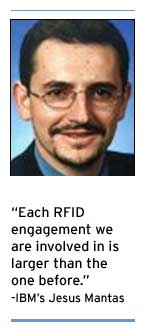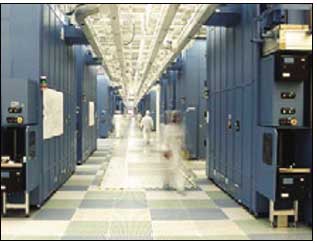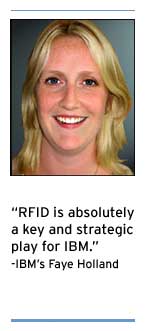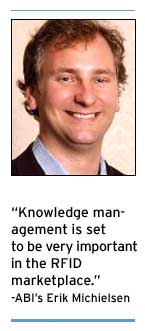In April 2003, as interest and spending in RFID systems began to swell, IBM formed its RFID emerging-business unit with the goal of coordinating the company’s resources to best tap into the emerging market. Just a year and a half later, the company says its RFID business has grown significantly.
“We have experienced vast growth over the past 18 months—in terms of both revenues and people. In April last year, we had around 400 IBM staff involved, and now I lead a community of over 1,200 people over three geographies,” says Faye Holland, worldwide RFID leader for IBM Global Services, and the person charged with promoting the technology within IBM as well as growing IBM’s RFID business.
The company announced in late September that it had earmarked $250 million to develop RFID products, laboratories and customer projects during the next five years, and had already says it has already begun to disbursing some of that money.
Analysts agree the company has invested in quickly building up its RFID business. “IBM has staffed up its RFID efforts significantly with regional and industry vertical training across multiple groups in business consulting, hardware, software and technology groups,” says Erik Michielsen, director of RFID and ubiquitous technologies at ABI Research, a consulting firm based in Oyster Bay, N.Y.
But despite all the growth and scaling-up of IBM’s RFID activities, head count at IBM’s RFID emerging-business unit has stayed flat at just one employee—Faye Holland. It is a situation that reflects the way the IT giant has tackled the challenge of growing and adapting to the demands of an RFID business that touches many areas of its existing operations.
IBM’s RFID emerging-business unit is a cross-IBM virtual organization within IBM Global Services that taps consulting, building, and testing expertise from IBM Global Services as well as research from IBM research division, industry-related skills from its industry-specific organizations, and software from IBM’s software group. For its part, the Global Services division combines IBM’s Business Consulting Services (BCS) and Integrated Technology Services (ITS) units to provide business and technical consulting, as well as deployment, testing and maintenance services.
Rather than set up a specific RFID business, IBM has opted to use the RFID emerging-business unit structure to incubate its RFID operations within its services organization and deliver related support to its separate industry-specific operations within the company. “RFID is applicable to a wide range of industries and uses. The goal of the RFID emerging-business unit is to promote RFID within IBM so that each industry unit builds its own RFID business,” Holland says.
The company is taking a similar approach within its software division. In September, the software division announced the formation of its Sensor and Actuator unit, which has the responsiblility for developing software products that will bring together IBM’s existing software offerings and add RFID-specific capabilities. Like Faye Holland’s RFID unit in IBM Global Services, Sensor and Actuator will draw from IBM staff employed within a range of other IBM organizations.
As the RFID market matures and customers look for more mature services, IBM says, its Global Services RFID emerging-business unit will also mature, and its skills and knowledge will be handed off to those business groups.
The growth in IBM’s RFID business has been the direct result of booming demand. In the past year, IBM says, the number of RFID projects it is working on has grown by as much as 10 times, and growth is set to continue. “Each RFID engagement we are involved in is larger than the one before. Most companies hadn’t even budgeted for RFID in this calendar year, and if they had, it was only a small amount,” says Jesus Mantas, who—as partner for global wireless for IBM’s Business Consulting Services—works with IBM customers on their RFID implementations.IBM has a long history with RFID. For more than 10 years, the company has worked on specialized RFID projects and even developed RFID patents for how tags and readers communicate. However, the company sold its nascent RFID operations and patents to Everett, Wash.-based RFID systems provider Intermec Technologies seven years ago.
Even without readers and tags, IBM can still be a one-stop shop for any RFID project—from business case to full deployment. “IBM has been very active across multiple areas of RFID. They are not part of tagging and reading the item, but they have products from edge servers through the entire value chain and through enterprise applications,” Michielsen says.
Rather than set up a specific RFID business, IBM has opted to use the RFID emerging-business unit structure to incubate its RFID operations within its services organization and deliver related support to its separate industry-specific operations within the company. “RFID is applicable to a wide range of industries and uses. The goal of the RFID emerging-business unit is to promote RFID within IBM so that each industry unit builds its own RFID business,” Holland says.
The company is taking a similar approach within its software division. In September, the software division announced the formation of its Sensor and Actuator unit, which has the responsiblility for developing software products that will bring together IBM’s existing software offerings and add RFID-specific capabilities. Like Faye Holland’s RFID unit in IBM Global Services, Sensor and Actuator will draw from IBM staff employed within a range of other IBM organizations.
As the RFID market matures and customers look for more mature services, IBM says, its Global Services RFID emerging-business unit will also mature, and its skills and knowledge will be handed off to those business groups. That would leave IBM well positioned to provide the key tools to enable RFID data to be integrated with existing enterprise applications. “A planned packaged RFID architecture from IBM will take advantage of key WebSphere components like WebSphere Application Server and WebSphere MQ for reliable messaging, as well as DB2,” says Sharyn Leaver, vice president and research director at Forrester Research, which is based in Cambridge, Mass.
IBM has already trialed its potential RFID middleware offerings at one of its own RFID deployments. A new automation process at its Fishkill, N.Y., semiconductor facility uses IBM’s own SiView Standard manufacturing execution system integrated with its IBM DB2 Database and IBM WebSphere MQ messaging platform and IBM WebSphere Application Server in conjunction with passive RFID tags attached to carriers of 300mm semiconductor wafers.
IBM, however, can already offer a single source for companies looking for someone to plan and implement an RFID system, but only through relying on strategic partners to deliver the tags, readers and connectivity middleware for any deployment.
“IBM has 25 partner companies actively working on readers and tags and has strong relationships with Philips Semiconductor, tag providers including Alien Technology, Intermec and Avery Dennison and, in the reader space, Intermec, Symbol and SAMsys,” Holland says. “We never wanted to be in the reader business, and we still don’t.” At the reader-management level, IBM has partnership agreements with RFID middleware vendors including OATSystems and ConnecTerra.
Despite these partnership agreements, some analysts believe in the long term, IBM may well replace some of its partner’s middleware with its own offerings. “IBM has been integrating applications for a long time, and it’s a lot easier for it to develop RFID connectivity and the algorithms for data filtering than it is for new companies to move into that application integration space. Replacing partner software such as OATSystems’ and ConnecTerra’s would give IBM a very complete enterprise RFID offering,” Leaver says.
IBM maintains, however, that the potential market for RFID services and the variety of situations in which RFID may be deployed means partnerships will always be essential. “We subcontract selectively for specialized knowledge or because of company constraints. No company could scale to the number of markets and opportunities for RFID,” Mantas says.Given the broad potential of RFID to be deployed across many industries and geographies, the appeal of RFID to IBM is understandable, according to analysts. “RFID is just one component in the mix, but it is a key part of a new generation of distributed computing that touches upon most of IBM’s big core hardware, software and services businesses,” Michielsen says.
IBM can already claim notable success in RFID, having worked on some of the largest and highest-profile RFID deployments in the world. In March, for example, the U.S. Department of Defense awarded a three-year contract to IBM Business Consulting Services to help manage and support the DOD’s planned deployment of RFID technology in 2005 (see IBM to Guide DOD RFID Rollout). Two months earlier, IBM had been named as a key technology provider to German retail giant Metro Group’s planned RFID rollout (see Metro Opens ). Those deals and others, IBM says, are the result of a significant financial investment and commitment to RFID within the company.
“RFID is absolutely a key and strategic play for IBM,” say Holland, who adds that with each RFID pilot, the company is fine-tuning its RFID capabilities. “We have developed a strong RFID solution and framework by understanding the pain points in any deployment. We have tested systems with customers, seen if they work and refined them.”
IBM says that while it will build out RFID deployments on a common platform across its industry-focused business divisions, it is the role of the company’s RFID team leaders in each vertical to understand and develop an RFID offering and value proposition for their industry. “We have componentized a lot of what we do,” says Mantas.
To support IBM’s RFID efforts, the company has also launched three RFID research labs where customers attend RFID education programs or test their products with a range of RFID tags and readers. With labs in Gaithersburg, Md., in Kanagawa, Japan and most recently in La Gaude, France, IBM is looking to cover each of the three markets it divides the world into. The lab’s far-flung locations also underline the worldwide capabilities of Big Blue. “In the RFID services market, global reach is absolutely essential,” Michielsen says.
The goal of IBM’s RFID efforts so far is to deliver a cohesive approach to RFID across its research, consulting and software divisions so that its industry-focused operations can then build on those established frameworks to develop systems and products targeted to the requirements of their specific markets.
“Very early on in IBM’s RFID efforts, we realized that we had to offer technology solutions, but with a specific industry points of view,” says Mantas,In September 2003, six months after it formed its RFID business, IBM introduced an RFID service specifically for its retailer and consumer packaged goods customers (see IBM Introduces New RFID Services). The offerings comprise consulting and implementation services, as well as specialized software in a three-phase approach. Phase one includes consulting and development of the business case for RFID deployment, with IBM charging an average of $200,000 for the service. Phase two involves deploying a 12-week pilot, with IBM charging around $500,000. The final phase is the full rollout of the RFID system. Pricing at this stage depends on the size and scale of the deployment.
A year later, the company rolled out a swathe of similar offerings developed by a number of its individual industry-sector organizations to address deployments in their respective industries. These include automotive, electronics, chemical and petroleum, forest and paper and aerospace and defense (see IBM Expands RFID Services). “As retail and CPG mandates approach, more and more pilots are moving into full production, so industry sectors like electronics are looking not just at compliance but at using RFID as an optimization or business-transformation play,” Mantas says.
The company will also target midsize businesses with a specific offering, believing there is obvious potential in that market. “Eighty-five percent of the companies that have to comply with mandates from Wal-Mart and the DOD are in the mid-market,” says Holland.
Those offerings have grown directly from the organization of IBM Global Services, which comprises seven industry vertical businesses, including retail and consumer products, automotive and pharmaceutical. In each of these divisions, IBM executives take the lead for RFID product and project development, but anyone working on RFID technology or interested in its potential can join the company’s RFID initiatives overseen by Faye Holland. For example, there is a weekly teleconference held to discuss ongoing RFID projects as well as business partner news and potential opportunities. IBM employees working with RFID also have access to an RFID-related database to find answers to issues that may have already been tackled elsewhere in the company.
Because IBM’s involvement with custom and specific closed-loop RFID implementations reaches back more than 10 years, Holland sometimes finds herself surprised at the depth of RFID experience within the company. “Communication works really well [within IBM’s RFID corporate community], but we still find people popping up in Brazil who have been working on RFID for the past two years or someone else who has been working on an RFID project in Europe for more than 10 years,” says Holland.
For vendors such as IBM, the sharing of RFID knowledge within a company will become increasingly essential as RFID deployments start to move from the current early pilot stage through to wide-scale deployment, say analysts. “Knowledge management is set to be very important in the RFID marketplace. There are going to be so many applications and potential projects that consultants will have to allocate resources effectively, and capturing learned experience means being better able to select the most suitable contracts and deliver better results,” Michielsen says.
According to IBM, the vast majority of the RFID market still remains at the business-case and planning stages, but customers are now increasingly looking past mandates to how they can deploy RFID deeper into their operations. “This year the two categories of business case and pilots converged. The majority are assessment and pilot only, but in the past six months, companies have started to take a dual approach. They want a solution for any mandates they might have to meet, but also what want a business case for using RFID in their own operations,” says Holland.
No different from many of its clients, IBM is now preparing a few internal RFID supply chain trials of its own during the next six months. “We looked at this just as we would for a client,” says Holland “We found a number of potential areas where RFID could improve performance, and these were cut down to the one or two that will provide the best return.”





